Avalanche Categories
Taking a general look at the avalanche catagories and avalanche size ratings.
There is a five-level European avalanche danger scale to indicate the avalanche danger. The danger level depends on a range of variables, in particular the snowpack stability (or avalanche triggering probability), the prevalence of avalanche prone locations and the avalanche size. A danger level always applies to a region and not to one particular slope. The danger level given in the avalanche bulletin is always a forecast and should be taken as only part of a bigger picture that you’re trying to paint, on the avalanche conditions and snowpack stability related to the specific area you’re in looking at and examining all the relevant factors.
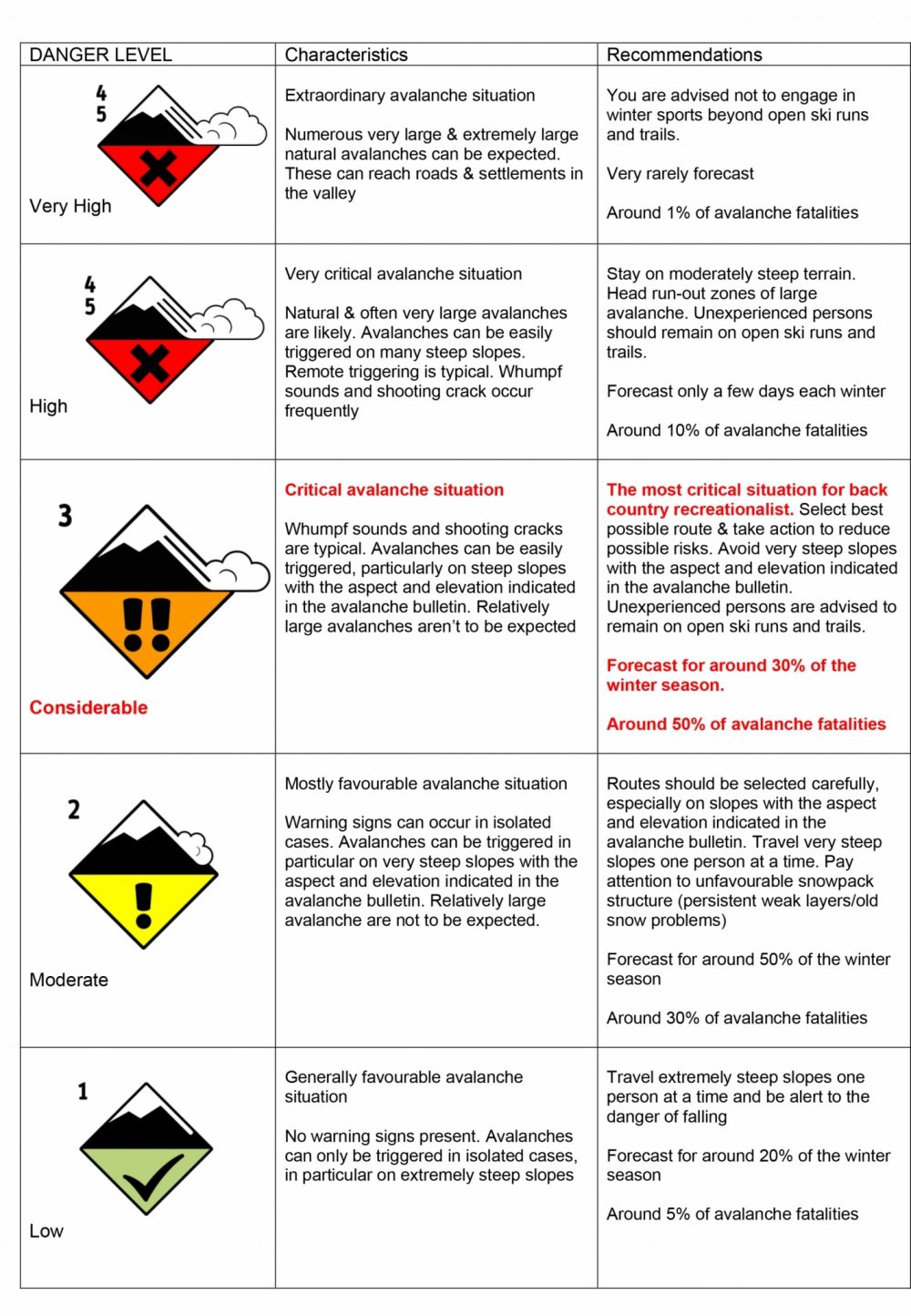
In many ways, the most important catagory here is CAT 3 - Considerable - which is why I've highlighted it in the table above
Cat 4 and then higher still Cat 5 is the most serious, but you're more than likely either not be off-piste skiing, touring or exploring at all, or you'll be very very cautious on what you do or where you go with very limited exposure to any slopes of any altitude, aspect or angle at this time.
We will regularly see the avalanche forecast as being 'Considerable' and it's likely we'll be out skiing and climbing during these forecasts. Cat 3 shouldn't be seen as only the 'middle' catergory but more that the avalanche forecast is 'Considerable'. It's durinmg these times that most avalanches are triggered and we see most avalanche accidents and fatalities.
Learn the basics of ski touring with a thread of avalanche awareness and certification in Avalanche training - Level 1 from the Swiss Mountain
Training Organisation and The Association of Swiss Mountain Guides on our Ski Touring Skills - instructional course.
Avalanche size Categorization
The European avalanche warning services divide avalanches into five size categories (based on the Canadian classification). The avalanche size is defined, among other things, by the potential damage caused.
Under this definition, fatal 'skier-triggered avalanches' are often classified as 'medium' or very rarely as 'large' avalanches, and reaches considerable dimensions, being typically 150 m in length and having a slab size of some 50 m by 80 m and an average slab thickness of around 50 cm. This is equivalent to a slab volume of approximately 2000 m3 or around 400 tonnes.
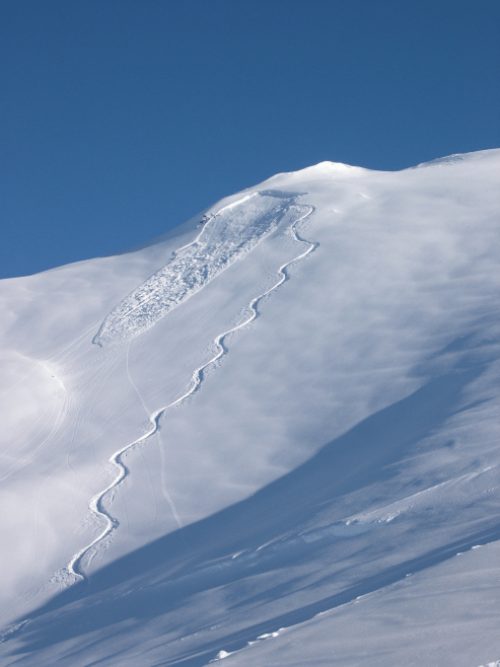
Size 1 – Small Avalanches (sluff)
Potential damage -
- Unlikely to bury a person, except in unfavourable runout zones
- In extreme terrain there is a danger of falling.
Runout -
- Stops on a steep slope
Typical dimensions -
- Length: < 50 m
- Volume: 100 m3
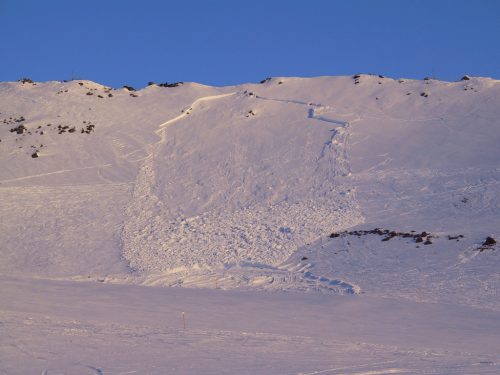
Size 2 – Medium Avalanche
Potential damage -
- Can bury, injure or kill people
- Many avalanches that kill people are classified as 'medium'.
Runout -
- Can reach the end of the relevant slope
Typical dimensions -
- Length: 50 – 200 m
- Volume: 1000 m3
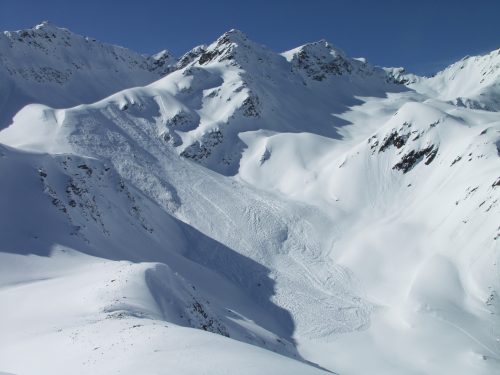
Size 3 – Large Avalanche
Potential damage -
- Can bury and destroy cars, damage trucks, destroy small buildings and break a few trees
- Many avalanches that kill people are classified as 'large'.
Runout -
- Can cross flat terrain (well below 30°) over a distance of less than 50 m
Typical dimensions -
- Length: Several hundred metres
- Volume: 10,000 m3
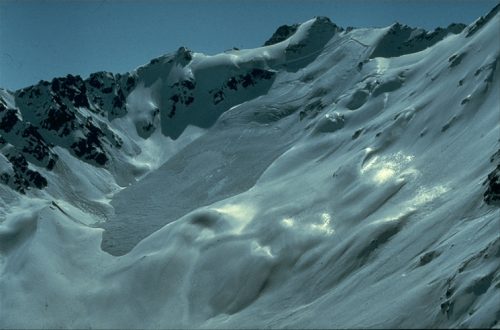
Size 4 – Very Large Avalanche
Potential damage -
- Can bury and destroy trucks and trains Can destroy fairly large buildings and small areas of forest. Very large avalanches can occur at danger level 3 and are typical of danger levels 4 and 5.
Runout-
- Traverses flat terrain (well below 30°) over a distance of more than 50 m
- Can reach the valley floor
Typical dimensions -
- Length: > 2 km
- Volume: 100,000 m3
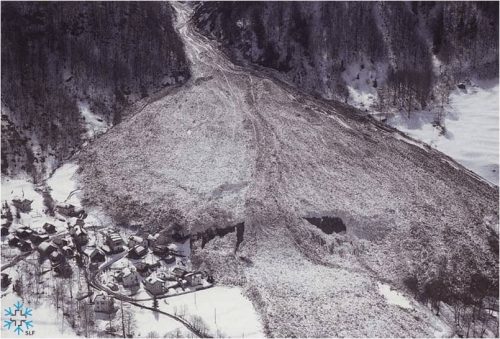
Size 5 – Extremely Large Avalanche
Potential damage -
Can devastate the landscape and has catastrophic destructive potential
Typical for danger level 5
Runout -
- Reaches the valley floor
Largest known avalanche - typical dimensions
- Length: > 2 kmVolume: > 100,000 m3
Images and text from the SLF Website - There is some great information on the ‘WSL Institute for Snow Avalanches Research SLF’ website - HERE
In Scotland there is the ‘Scottish Avalanche Information Service’ – SAIS
The SAIS does a lot of great work with people out in the mountains everyday throughout the winter, digging pits, and observing the snow conditions to bring accurate data back to create the avalanche forecasts we see on-line.
There is also a really nice ‘Be Avalanche Aware’ leaflet that the SAIS have pulled together, that you can also view HERE
It’s a really helpful guide outlining the decision-making process and the fundamental considerations of assessing avalanche hazards in the winter mountains. With the advice on these pages, together with the corresponding resources overleaf, you should be able to make better judgements on where and when to go.
One key point to mention here also, is that all the images and text typically evolve around activities that we do in the winter. Avalanches are prevalent outside of the the classic winter months. Avalanches in the summer claim many lives, either early season when the days rapidly heat up and any sloppes still laidened with snow avalanche, or maybe then storms that blow through mid-season depositing wind-blown snow on hard icy surfaces, will also be a trap waiting to be triggered.
So for me 'Be Avalanche Aware' all year round, and just because it's the summer season, it doesn't mean that you can climb the day after a heavy snowfall. Wait and allow time for the snow to clean up on those high mountain slopes, you wouldn't climb the day after heavy snow in the winter and so why would you in the summer? Temperatures and conditions up at 4000m can be like the winter even though you're in the middle of the summer, and the snow acts and forms in the same ways.
I hope that helps a little
Adrian Nelhams
Related News Articles

ISM Virgin Peaks Expedition 2024 - Tien Shan Kyrgyzstan
ISM trip report of our trip into a very remote part of the Tien Shan Mountains, Kyrgyzstan
Read Article
Getting Into & Developing Your Climbing
Indoor bouldering is a great place to start if you want to try climbing for the first time. You can…
Read Article
ISM Virgin Peaks Expedition 2023 – Tien Shan Kyrgyzstan
ISM trip report of our trip into a very remote part of the Tien Shan Mountains, Kyrgyzstan.
Read Article
Kyrgyzstan Faces 2022
This year ISM celebrated 25yrs of expedition climbing in Kyrgyzstan, with a fantastic trip to the Fergana Range in the…
Read Article



